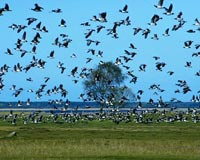| . |  |
. |
Washington (AFP) Dec 3, 2010 Crippled by drought, scorched by wildfires and dying from beetle infestations, forests in the American west are struggling and in some states they now exude more carbon than they absorb, experts say. In an attempt to uncover what the future holds for these ancient pine forests, scientists are studying how trees recover and regrow, and what forest managers can do to help them respond to the modern stresses of climate change. "These systems are changing, kind of underneath us. It is slower than the nightly news cycle, that is for sure, but it is changing. And so we have to keep changing our management approach," said David Cleaves, the top climate change adviser at the US Forest Service. America's forests, the fourth largest in the world, have served as an important net carbon sink for much of the past century, absorbing more carbon dioxide from the atmosphere through photosynthesis than they exude through decomposition and timber harvesting. The carbon sink amounts to 162 teragrams of carbon per year and offsets about 10 percent of total US fossil fuel emissions, according to the US Forest Service. But US forestlands were a major source of carbon from about 1800 until 1930, when pioneers cleared vast areas of land for settlement and timber was widely used for fuel and mass construction projects. Some of the most iconic forests in the Interior West region -- home to towering pines, the soaring snow-topped Rocky Mountains and vast national parklands like Yellowstone -- have been hit hard in recent years by unusually dry seasons, melting ice packs, and plagues of fires and insects. Two of those states, Arizona and Idaho, have flipped to become carbon sources rather than sinks, according to data released in April by the Environmental Protection Agency, averaging annual changes over time. Another study in 2007, published in the journal Forest Ecology and Management, suggested Colorado and Wyoming were showing similar signs. "The intermountain west is clearly an area of the most concern because of fire, mountain pine beetle and drought," said Richard Birdsey who heads the Climate, Fire, and Carbon Cycle Sciences project at the Forest Service. "They have been hit by three of the main factors all around the same time. So they are under a lot of stress," he said, adding that beetles have damaged ten of millions of acres and killed many trees. "All those dead trees are still standing. They haven't released all of their carbon yet. They take two to three decades." A 2009 study led by the US Geological Survey suggested that the death rate in Western forests has doubled, and that forests would become sparser in the future, and be able to store less carbon. In some cases, forest managers can help a struggling forest by thinning trees, allowing more light and water for those that remain and eliminating some stresses that can help tree-killing beetles gain the upper hand. In other cases, Mother Nature may know best how to resprout after a fire. Researcher Erica Smithwick has been studying the resiliency of the lodgepole pines, the thin tall trees that are the most common in Yellowstone, and which reproduce via cones that only release seeds in conditions of extreme heat. That innate ability to regrow under harsh conditions has helped some areas bounce back from the 1988 fires that scorched 793,000 acres at Yellowstone, or more than one third of the parkland. But other areas have recovered more slowly. Historically, most area ecosystems have been able to recover their carbon in 75-100 years, she said. But if fires occur more frequently, that could shift the landscape. "If we expect to see fire return intervals that are much shorter, then we need to think about how we want to manage for that and look ahead to what that means for the ecosystems of this landscape," she said. According to Mike Ryan at the Forest Service's Rocky Mountain Research Station in Colorado, it is crucial to make sure new trees can grow. "From a carbon standpoint the best thing that a manager can do is make sure you get regeneration," said Ryan. The US Forest Service downplayed the sink-to-source trend, saying that areas can flip back and forth over short periods but the trend is unlikely to force American forests on the whole to be net oozers of carbon in the near future. "Our history is relatively short compared to the history of the forest so it is hard to tell," said Ryan. "If our future holds that we are going to have more disturbances, then our forests are going to hold less carbon."
Share This Article With Planet Earth
Related Links Forestry News - Global and Local News, Science and Application
 Many Coastal Wetlands Likely to Disappear this Century
Many Coastal Wetlands Likely to Disappear this CenturyReston, VA (SPX) Dec 02, 2010 Many coastal wetlands worldwide - including several on the U.S. Atlantic coast - may be more sensitive than previously thought to climate change and sea-level rise projections for the 21st century. U.S. Geological Survey scientists made this conclusion from an international research modeling effort published in the journal Geophysical Research Letters, a publication of the American Geophys ... read more |
|
| The content herein, unless otherwise known to be public domain, are Copyright 1995-2010 - SpaceDaily. AFP and UPI Wire Stories are copyright Agence France-Presse and United Press International. ESA Portal Reports are copyright European Space Agency. All NASA sourced material is public domain. Additional copyrights may apply in whole or part to other bona fide parties. Advertising does not imply endorsement,agreement or approval of any opinions, statements or information provided by SpaceDaily on any Web page published or hosted by SpaceDaily. Privacy Statement |